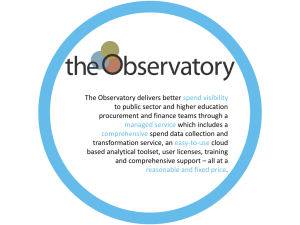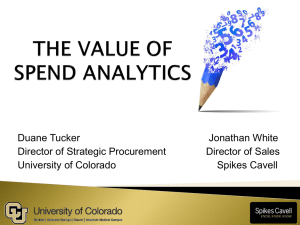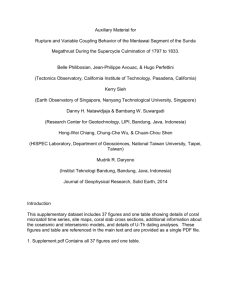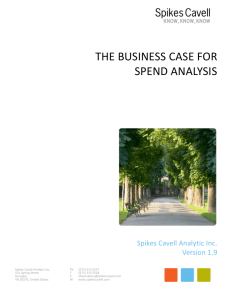Service Definition – Spikes Cavell Analytic Ltd Data Processing
advertisement
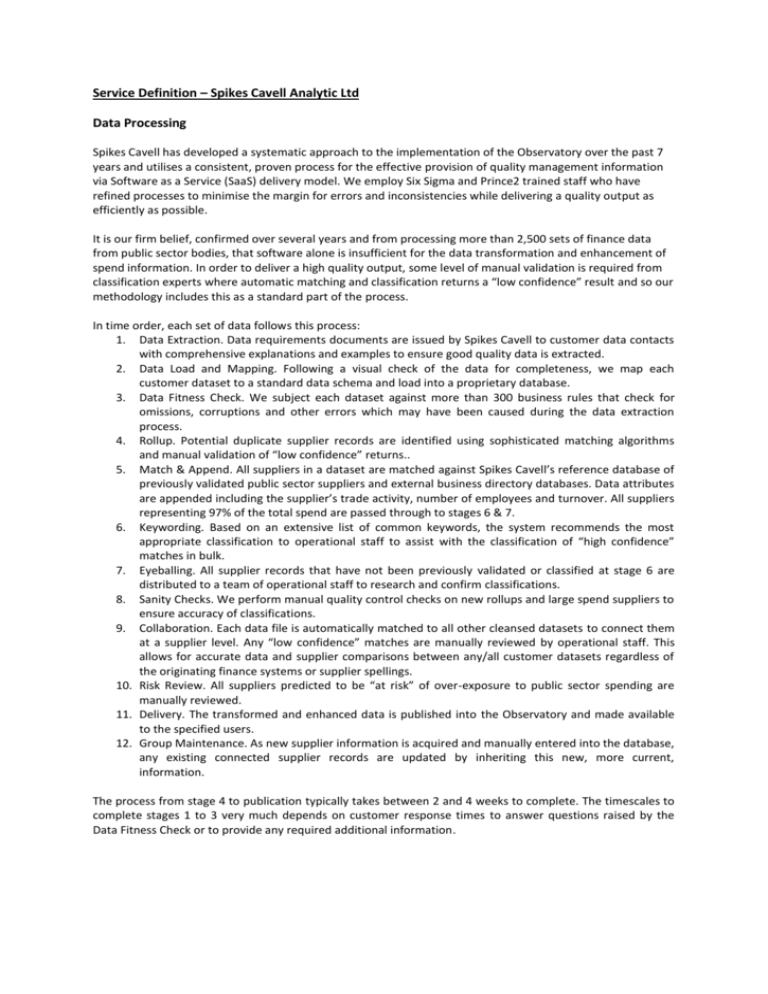
Service Definition – Spikes Cavell Analytic Ltd Data Processing Spikes Cavell has developed a systematic approach to the implementation of the Observatory over the past 7 years and utilises a consistent, proven process for the effective provision of quality management information via Software as a Service (SaaS) delivery model. We employ Six Sigma and Prince2 trained staff who have refined processes to minimise the margin for errors and inconsistencies while delivering a quality output as efficiently as possible. It is our firm belief, confirmed over several years and from processing more than 2,500 sets of finance data from public sector bodies, that software alone is insufficient for the data transformation and enhancement of spend information. In order to deliver a high quality output, some level of manual validation is required from classification experts where automatic matching and classification returns a “low confidence” result and so our methodology includes this as a standard part of the process. In time order, each set of data follows this process: 1. Data Extraction. Data requirements documents are issued by Spikes Cavell to customer data contacts with comprehensive explanations and examples to ensure good quality data is extracted. 2. Data Load and Mapping. Following a visual check of the data for completeness, we map each customer dataset to a standard data schema and load into a proprietary database. 3. Data Fitness Check. We subject each dataset against more than 300 business rules that check for omissions, corruptions and other errors which may have been caused during the data extraction process. 4. Rollup. Potential duplicate supplier records are identified using sophisticated matching algorithms and manual validation of “low confidence” returns.. 5. Match & Append. All suppliers in a dataset are matched against Spikes Cavell’s reference database of previously validated public sector suppliers and external business directory databases. Data attributes are appended including the supplier’s trade activity, number of employees and turnover. All suppliers representing 97% of the total spend are passed through to stages 6 & 7. 6. Keywording. Based on an extensive list of common keywords, the system recommends the most appropriate classification to operational staff to assist with the classification of “high confidence” matches in bulk. 7. Eyeballing. All supplier records that have not been previously validated or classified at stage 6 are distributed to a team of operational staff to research and confirm classifications. 8. Sanity Checks. We perform manual quality control checks on new rollups and large spend suppliers to ensure accuracy of classifications. 9. Collaboration. Each data file is automatically matched to all other cleansed datasets to connect them at a supplier level. Any “low confidence” matches are manually reviewed by operational staff. This allows for accurate data and supplier comparisons between any/all customer datasets regardless of the originating finance systems or supplier spellings. 10. Risk Review. All suppliers predicted to be “at risk” of over-exposure to public sector spending are manually reviewed. 11. Delivery. The transformed and enhanced data is published into the Observatory and made available to the specified users. 12. Group Maintenance. As new supplier information is acquired and manually entered into the database, any existing connected supplier records are updated by inheriting this new, more current, information. The process from stage 4 to publication typically takes between 2 and 4 weeks to complete. The timescales to complete stages 1 to 3 very much depends on customer response times to answer questions raised by the Data Fitness Check or to provide any required additional information. The Observatory The Observatory is a suite of analytical tools accessed over over the internet asSaaS viavia a secure sign on process which is unique for each registered user. These tools have been designed with procurement professionals in mind and are organised into groups of reports for particular types of analysis, comparison or for the identification of common spend, it is not essential for a user to have any kind of analytical background or training to gain valuable management information from the application. Depending on the options selected for the subscription purchased, a user will have access to analytical reports covering: Creditor profiles Duplicate supplier record analysis Spend distribution Invoice distribution Transaction type (i.e. Procurement Card spend analysis) Supplier size (SME) Supplier age Supplier location (local spend) Supplier dependence Category analysis Department/cost centre spend Comparison of spend profiles with other public sector bodies & sector averages by type of organisation Common supplier analysis Common category spend analysis Spend with non-contracted suppliers Timeline analysis Measurement of savings and efficiencies Local suppliers not currently used Publication of spend data to meet the requirements of transparency Spikes Cavell recommends that organisations should update their data at least annually; options are available for monthly or quarterly updates of spend to the Observatory. All data can be downloaded from the Observatory quickly and easily in Microsoft Excel or Access or in .csv format. Any chart or graph displayed in a report can also be downloaded or saved to a local computer. User Support and Training Once published to the Observatory, all users are offered a series of training courses, delivered by webinar covering all aspects of the Observatory including Basic User Training, Category Management Analysis, Data Input, Contracted Supplier Analysis plus other sessions as customer needs are identified. Spikes Cavell also provides a number of self-help guides and videos to assist users with all aspects of the Observatory. Product support is provided to all users via email and/or telephone by an experienced team of support staff and product specialists. Training and support is available as often as required while the user is a current customer with a valid user licence. A subscription to the Observatory runs from the date of purchase order for 12 months. Upon subscription expiry a customer has three options: 1. Renew their subscription and provide another set of data for analysis 2. Purchase an access only licence to continue to access the data in the system 3. Lapse their subscription upon which access to their data will be removed in the Observatory and all user licences cancelled Security, Backup and Disaster Recovery The live Observatory is unavailable to users between the hours of 10pm and 5am for daily maintenance, a complete backup of all information and data updating procedures. Occasionally the Observatory will be taken offline for an extended period of time when major updates are posted, during these and any other times during business hours where the live Observatory is offline a mirrored version of the application is made available to users. The Observatory mirror is hosted in a secure datacentre in separate location to the live Observatory. Please see the following attached documents for details of Spikes Cavell’s data handling, security and protection policies. Spikes Cavell Analytic Ltd - Service Definition Appendix A - Data Protection Policy (Client Data Received).pdf Spikes Cavell Analytic Ltd - Service Definition Appendix B - Data Protection Policy.pdf Spikes Cavell Analytic Ltd - Service Definition Appendix C - Data Security Policy.pdf Pricing Prices for an annual subscription to the Observatory are based on the type and size of public sector body subscribing. For the smallest organisations pricing starts at £2,940 however, for larger organisations a basic subscription rises to reflect the amount of work involved in processing data and supporting a larger number of users. Organisation types are grouped into bands and priced accordingly, the bands are: A – Police Force, Fire & Rescue Service, College B – English District or Borough Council, Small Central Government Body C – Education - University, Super College D – Unitary Council, London Borough Council, Medium Central Government Body, Ambulance Service E – Metropolitan Borough Council, Health Board F – County Council, Large Central Government Body Discounts from standard pricing are available to customers renewing their subscription to the service, for organisations buying multiple years or for groups of organisations subscribing together.
